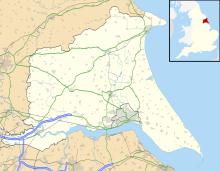RAF Carnaby
|
RAF Carnaby |
|||||||||||
|---|---|---|---|---|---|---|---|---|---|---|---|
| Summary | |||||||||||
| Airport type | Military | ||||||||||
| Owner | Air Ministry | ||||||||||
| Operator | Royal Air Force | ||||||||||
| Location | Carnaby | ||||||||||
| Built | 1943 | ||||||||||
| In use | 1944–1945 1959–1963 |
||||||||||
| Elevation AMSL | 10 m / 33 ft | ||||||||||
| Coordinates | 54°03′39″N 000°15′42″W / 54.06083°N 0.26167°WCoordinates: 54°03′39″N 000°15′42″W / 54.06083°N 0.26167°W | ||||||||||
| Map | |||||||||||
| Location in East Riding of Yorkshire | |||||||||||
| Runways | |||||||||||
|
|||||||||||
RAF Carnaby was a Royal Air Force emergency landing strip that offered crippled bombers a safe place to land near the English coast during the Second World War. It was situated 2.0 miles (3.2 km) south-west of Bridlington, East Riding of Yorkshire.
RAF Carnaby opened in March 1944. Unlike most RAF airfields, there was a single runway, five times the width of a standard runway and 9,000 ft (2,700 m) long, lying approximately east-west to enable bombers crossing the coast an easier landing. Two similar airfields were either constructed or further developed along the east coast of England, at Manston and Woodbridge, all three providing an emergency option for wartime bomber crews. The three airfields were developed to the same pattern, Woodbridge being the first to open in November 1943. The runway at Manston was brought into operation in April 1944.
Along with RAF Manston and RAF Woodbridge, Carnaby was developed as an east coast emergency landing ground for bomber crews. These airfields were intended for use by returning bombers suffering from low-fuel and/or suspected damage to their pneumatic (wheel brake) and/or hydraulic (undercarriage) systems. All three airfields were equipped with one runway, 9,000 ft (2,700 m) long and 750 ft (230 m) wide. There was a further clear area of 1,500 ft (460 m) at each end of the runway. At each of the three airfields, the runway was divided into three 250 ft (76 m) lanes. The northern and central lanes were allocated by flying control, while the southern lane was the emergency lane on which any aircraft could land without first making contact with the airfield. Over 1,400 bombers made an emergency landing at Carnaby by the end of the war.
Air chief marshal Basil Embry in Mission Completed believed that the three emergency runways were constructed as a result of the success of the 3 mi (4.8 km)-long landing strip and flarepath at Wittering in accepting over 70 damaged aircraft from Bomber Command. The runway had been lengthened in 1940 to reduce landing accidents to Beaufighter night fighters returning at night and in bad weather.
...
Wikipedia

